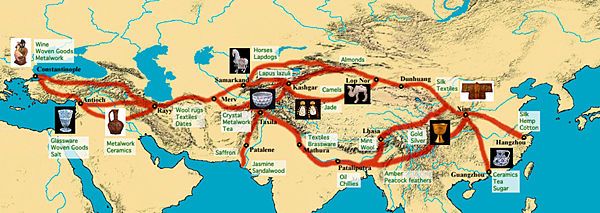Silk Road Transported Goods--and Disease
絲路互通商品也互通疾病
By Cynthia Graber on July 29, 2016
語音筆記:https://drive.google.com/open?id=0B-Bg0auB-gcoX3NEVFI0T3l1SVE
For thousands of years, what’s called the Silk Road was a group of land and sea trade routes(貿易路線) that connected the Far East with South Asia, Africa, the Middle East and southern Europe. Of course, when humans travel they carry their pathogens(病原體) with them. So scientists and historians have wondered if the Silk Road was a transmission route not just for goods, but for infectious disease.
幾千年來,所謂的絲路指的是一群陸地和海上貿易路線,將東亞連接到南亞、非洲、中東和南歐,當然,當人類旅行的時候,病原體也跟著一塊兒帶著,所以科學家和歷史學家一直想了解是否絲路不只是商品傳播路徑,也是傳染性疾病的傳播路徑
Now we have the first hard evidence(鐵證) of ancient Silk Road travelers spreading their infections. The find(發現物) comes from a 2,000-year-old latrine(茅坑) that had first been excavated(挖掘出來) in 1992. The report is in the Journal of Archaeological Science: Reports.
現在我們已經有古時候絲路旅行者散播傳染病的鐵證,這個證物來自兩千年歷史的茅廁,第一次挖掘出來是在1992年,這份研究報告刊登在考古科學報告期刊。
“So the site is a relay station(中繼站) on the Silk Road in northwest China. It's just to the eastern end of the Tarim Basin(塔里木盆地), which is a large arid area just to the east of the Taklamakan desert(塔克拉瑪乾漠), and not far from the Gobi Desert. So this is a dry part of China.”
Piers Mitchell, paleopathologist at the University of Cambridge, and one of the study’s authors, along with his student Ivy Yeh and colleagues in China.
In the latrine, archaeologists found used hygiene sticks(衛生籤) wrapped with cloth. These were used for what you think they were used for.
其次,它說明了這條路徑是可以用來傳播其它傳染病的路徑,例如黑死病(Bubonic plague)、痲瘋病(leprosy)和炭疽熱(anthrax),先前大家認為可能是沿著絲路散布到東亞和歐洲之間,因為現代遺傳學分析顯示兩造地點病株(strains)的相似度。
秘丘說,為了更深入了解全球疾病的散播,還有很多工作要做,或許可以分析絲路上骨骼或不同的殘骸(remains)。




 留言列表
留言列表


